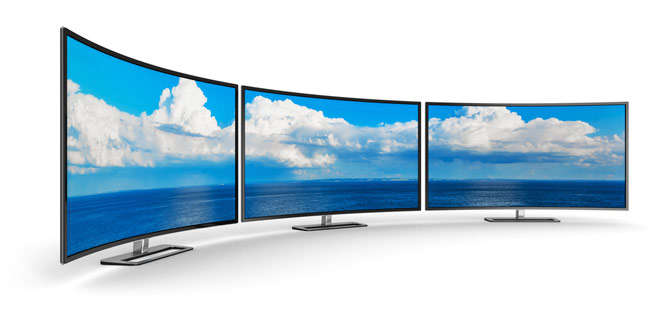Curved displays are widely talked about as the next big thing in display and TV technology. Most major brands are now offering products featuring a curved display – whether desktop displays for work or gaming, as well as TVs and public signage products.
As curved display products become more mainstream, they can also now qualify for TCO Certified.
We thought we’d take a look at some features of curved products and answer a few questions about their features and use.
What is a curved display?
Products with a curved display are typically TVs or desktop monitors. They have a wide aspect ratio and are designed with a horizontally curved panel to offer a more dynamic viewing experience. While curved projections screens (such as in movie theaters) have been around since the 1950s, curved displays are just now becoming more common and industry experts largely agree they are here to stay. Initially popular with TV buyers and computer gamers, curved displays are now appearing on the desktop as well.
An immersive user experience
Many brands promote that curved displays give the viewer a more immersive experience, so that you feel like you’re in the center of the image. The idea is that a curved display will give the user a wider field of view than a flat screen of the same physical size. In essence you are widening the field of peripheral vision, as the edges of the screen are closer to you.
By adding a curve to the wide displays we see today, manufacturers claim they have been able to further reduce any viewing distortions at the edges of the screen, as sometimes experienced by certain users. Opinions differ as to whether this is the case, or whether flat and curved panels deliver similar performance in this area. Viewer perception is of course individual and subjective.
As with any display, there are ways to position a curved display for an optimal viewing experience. The recommended position is to view the display directly along the central axis of the monitor with the central point of the screen at eye level.
What about sustainability issues?
Like any electronic device, we need to make sure that curved display product meets criteria for sustainable, responsible manufacturing, use and end of life handling. The TCO Certified sustainability criteria for curved displays are the same as for flat panel displays, with a minor adjustment in the test methods.
Can curved displays be TCO Certified?
Following some in-depth research looking at curved displays and the user experience, we have determined that products with a curved display can meet the display performance requirements in TCO Certified. It’s important to remember to ask for a TCO Certified display even when selecting a curved product.
Learn more about curved displays




